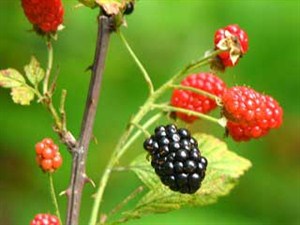A New Bramble Variety
I am always interested in any new variety of fruit that comes available to the home garden market.
The nursery, Incredible edibles, will soon be releasing a newly breed bramble called ‘Thornless Jewell’.
Breed by Plant & Food Research to produce a thornless bramble with easy care and a good flavour.

The news release from the Incredible Edibles states:
Brambles date back thousand years and are native to Asia, Europe, North & South America.
In proper botanical language, it is not a berry at all, but instead an aggregate fruit of numerous drupelets around a central core. They typically grows in forest clearings or fields, particularly where fire or wood-cutting has produced open space by this opportunistic colonizer of disturbed soil. The raspberry like flower can be a major nectar source for honeybees. As a cultivated plant in moist temperature regions, it is easy to grow.
In the last couple of hundred years blackberries, raspberries, loganberries and boysenberries have been crossed with each other producing hybridberries, working on attributes as flavour, thornless and climate suitability.
This new hybrid berry (also known as brambles) called Thornless Jewel is a cross between a blackberry and a raspberry.
Landscape Value: Train on a trellis to support fruit. Alternatively train like a pillar-rose.
Nutritional Value: High in antioxidants and rich in Vitamin C.
How to Eat: Fresh, fresh and fresh in Gran’s jam or add it to a fresh summer salad. Better still add them to a plate full of ice-cream. Watch the kids eat them straight off the plant.
Grow in full sun in a sheltered situation they do not tolerate wind & salty marine conditions.
Performs well in both warm and cool climates. Is frost tolerant as they become dormant.
Brambles prefer a slightly acidic soil and free draining. Mulch well to ensure the root systems remain moist during the growing season.
Feed with sheep manure pellets and blood & bone along with monthly sprinkles of potash during the spring and through till harvest in summer.
Spray foliage with Magic Botanic Liquid and Mycorrcin for plant health and increased crops.
Pruning: Prune in winter to remove all canes that have fruited and all damaged and weak canes. Remove canes to the base, any fully thorny canes should be cut off as low to the ground as possible. Tie up young trailing canes to a trellis system, they will fruit in the second year. Remove tips so canes do not become too long and encourage fruiting laterals.
Pests: Good hygiene and not growing plants in wet soils will keep many diseases at bay. Bird netting or Bird repeller ribbon may be needed as fruit is ripening. A spring spray of Neem Oil at bud burst for insectfestation and regular sprays will ensure fruit are pest free.
Hardiness: -5, Cold weather at flowering will result in poor pollination and therefore small fruit.
A bramble bush when mature will produce up to 5Kg of fruit.
If you consider that it costs about $3.50 for 100 grams in a supermarket during the season then your bramble is worth about $175.00 a year in fruit.
The biggest problem with brambles is their ability to spread and invade into gardens where you don’t want them.
Planted on a fence line boarding on a lawn area can be ideal and when any new shoots come up in the lawn they are cut off when mowing keeping the plant where you want it.
My solution to growing brambles has been to grow them in 45 litre plus containers using purchased compost as the growing medium.
In the spring I sprinkle chook manure, Fruit and Flower Power, Bio Boost and Rok Solid on top of the compost. Further applications of Fruit and Flower Power are applied monthly till harvest.
Using either stakes or wide plastic netting around the perimeter of the container keeps the canes in check and allows for picking. A strip of Bird Repeller Ribbon flapping in the breeze when the fruit are ripening keeps the birds at bay.
Here are a couple of recipes as alternatives to fresh and raw berries:
Boysenberry Parfait
Ingredients, 3 cups fresh or frozen boysenberries
3 cups fruit yogurt or 1 1/2 cup whipped cream
4 crumbled brandy snaps.
Method: Mix 3 cups fresh or frozen boysenberries with 3 cups fruit yogurt.
Or 1 1/2 cup whipped cream and 4 crumbled brandy snaps.
Sweeten if desired with 2 tbsp runny honey. Serve chilled.
Boysenberry Brûlée
Ingredients: Custard; 1 litre milk, warmed, ½ cup sugar, 6 eggs, 1 ½ tsp vanilla essence
Sauce: 500g frozen or fresh boysenberries, extra fresh boysenberries, ½ cup sugar (more or less to your taste.
Method: Preheat the oven to 180°C.
Place the milk and sugar in a saucepan and stir over low heat until the sugar has dissolved. Place eggs and vanilla in a bowl and whisk together for 2 minutes. Stir into the warm milk. Pour into 8 greased ½ cup ramekins.
Place the ramekins in a baking tin, and then pour hot water to come up halfway up the sides. Bake for 30 minutes or until custard is set where an inserted knife comes out clean. Allow to cool then refrigerate for at least 6 hours.
Slowing cook frozen boysenberries in saucepan until tender. Add a little water if needed. Once cooked and soft sieve out the berry pulp. Reheat the juice, stir in the sugar until dissolved. If needs thicking stir in 1tsp cornflour dissolved in 2 tbsp of water. Bring to boil stirring. Cook on low for 2 minutes. Remove from heat and cool.
To unmould ramekins, run a knife around the edge of custard and gently upturn onto a serving plate. Pour over the Boysenberry sauce. Serve with fresh boysenberries.
For those reader interested in the Thornless Jewell bramble place your order with your local garden centre – use the directory search panel to find your local garden center.

